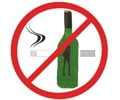
"Some teens begin adult behaviors ranging from sexual behavior to driving to taking their first job very early while others delay initiating these behaviors," added Victor Hesselbrock, professor of psychiatry at the University of Connecticut School of Medicine. "Novelty seeking is likely one of several personality factors that may influence the timing of the initiation of drinking behaviors. Many do consider teenage drinking a 'rite of passage,' given the ubiquity of the behavior across different environments and cultures."
"We tried to identify whether subgroups exist that follow similar changes in alcohol use over time," said Wichers. "This is important in order to differentiate adolescents in terms of their future course of alcohol use and identify the characteristics that may predict which course adolescents will follow."
"Most current studies of alcohol and other substance use in adolescence now use some variant of the 'developmental trajectories' approach," noted Hesselbrock. "This study is somewhat unique in that the sample size is fairly large and contains both girls and boys. Importantly, it assesses a number of relevant psychological traits and environmental factors considered either risk or protective for onset of drinking behavior. The sample also covers the age range of 15 to 36 years of age. This is important as it captures the typical age of initiation of drinking but also other drinking milestones such as first intoxication, onset of regular drinking, appearance of early drinking problems, as well as the period of time in early adulthood when drinking behaviors further diverge into different patterns."
Wichers and her colleagues obtained retrospective data from 1,560 adult male twins concerning their average monthly alcohol use, as well as risk and protective factors in their lives, through interviews and questionnaires. The age span addressed was from 15 to 36 years of age. Risk factors included parental alcohol use, poor school performance, and specific personality traits. Protective factors included religiosity, parental monitoring, and social activities.
"We found six different subgroups of individuals that could be clustered together in terms of their trajectories of alcohol use," said Wichers. "Alcohol use in these six trajectories differed in terms of, one, overall level of use, in that some subgroups used more alcohol than others, two, peak of alcohol use, in that some subgroups had a more pronounced early peak of use in early adolescence than other subgroups, and three, persistence of use, in that two subgroups were both characterized by a sharp increase in use during adolescence and high levels of use."
Advertisement
"After identifying these different subgroups, a second aim of this study was to find personal characteristics that might predict to what subgroup individuals may belong," said Wichers. "We found that a number of risks that predicted average alcohol consumption did not always predict the pattern of alcohol use over time. For instance, sensation seeking and low school performance were associated with a higher average level, but not with an early peak pattern, of alcohol use. On the other hand, peer deviance, ADHD symptoms, and genetic risk of externalizing disorders impacted on the timing of alcohol use in early adolescence. Among the most striking findings was that genetic risk for externalizing problem behavior and peer deviance was the strongest predictor of belonging to subclasses with initial high average consumption and an early peak in alcohol consumption during adolescence. In summary, this study showed that these predictors do not all influence alcohol use in the same manner: some predict increased level of use while others predict pattern of use in early adolescence or persistence of high-level alcohol use. Thus, indeed there seems to be a varied influence of certain factors at different stages in one's life."
Advertisement
Both Wichers and Hesselbrock said that future research is a necessity.
"Before a clinician can use these findings to construct an effective intervention, other research needs to examine whether these identified predictors are causal," said Wichers. "Then clinicians may use this knowledge to construct intervention strategies and identify individuals at risk."
"We need to determine whether behavioral, pharmacological, or both types of treatments targeted for specific classes will be more effective," said Hesselbrock. "We need to identify more specific genetic determinants that can be addressed either pharmacologically or by a behavioral intervention. It will also be interesting to see how these findings relate to quantity and patterns of use of other substances such as tobacco and marijuana, given that teens typically use a variety of substances, not just alcohol alone. Treatment providers should keep these different trajectories in mind and adjust their treatment plans as necessary as they follow their patients forward. Remember that this study is observational; the question remains whether these different class memberships and drinking trajectories can be changed with treatment."
Source-Eurekalert













